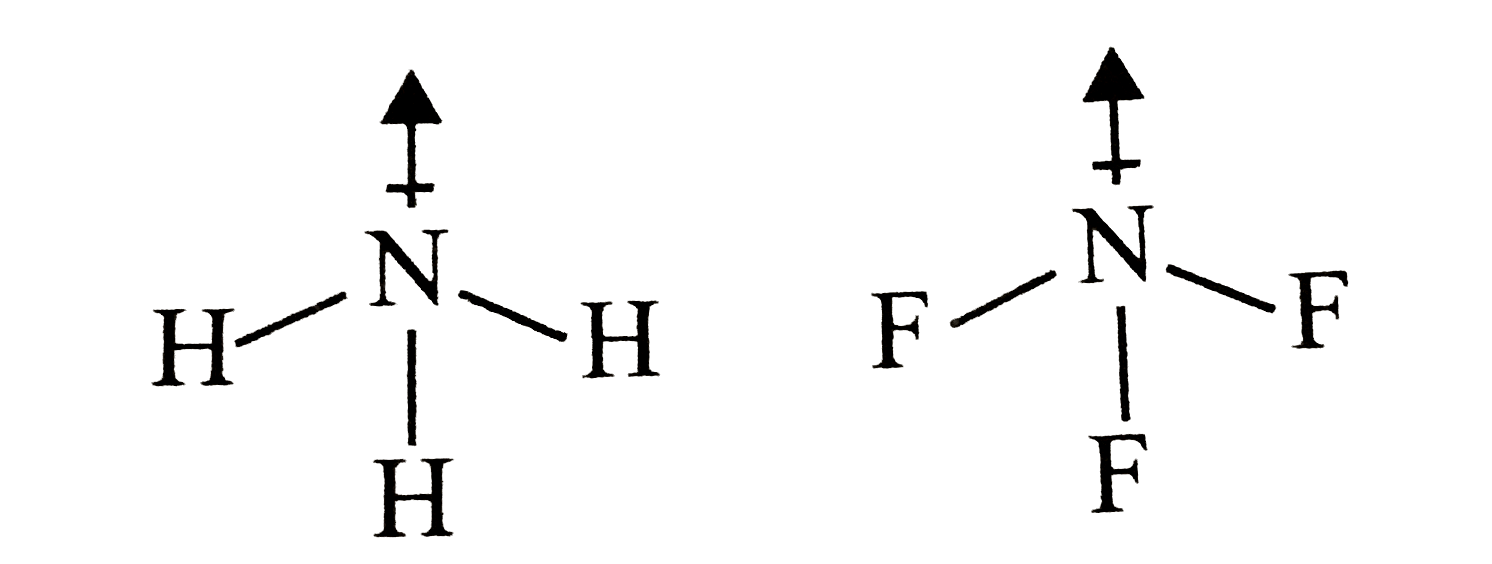The dipole moment of is much less as compared to that of because
1. the size of N atom is much less than that of H atom
2. F atom is more electronegative than N atom, whereas H atom is less electronegative than N atom
3. unshared electron pair is not present in
4. number of lone pairs in is much greater than in .
The correct Answer is:B
To understand why the dipole moment of NF₃ is much less compared to that of NH₃, we can analyze the factors affecting dipole moments in these molecules step by step.
1. Understanding Dipole Moment:
- The dipole moment (μ) is a measure of the separation of positive and negative charges in a molecule. It depends on the electronegativity of the atoms involved and the geometry of the molecule.
2. Electronegativity Comparison:
- In NH₃ (ammonia), nitrogen (N) is more electronegative than hydrogen (H). This means that the N-H bonds have a significant dipole moment directed towards nitrogen.
- In NF₃ (nitrogen trifluoride), fluorine (F) is more electronegative than nitrogen. Thus, the N-F bonds have a dipole moment directed towards fluorine.
3. Molecular Geometry:
- Both NH₃ and NF₃ have a trigonal pyramidal shape due to the presence of a lone pair on nitrogen. However, the lone pair in NH₃ contributes to the overall dipole moment in the same direction as the N-H bonds.
- In NF₃, the lone pair is directed opposite to the N-F bonds, which reduces the overall dipole moment.
4. Resultant Dipole Moment:
- In NH₃, the dipole moments of the N-H bonds add up with the contribution from the lone pair, resulting in a higher dipole moment (approximately 1.46 Debye).
- In NF₃, the dipole moments of the N-F bonds are opposed by the lone pair’s contribution, resulting in a lower dipole moment (approximately 0.24 Debye).
5. Conclusion:
- The dipole moment of NF₃ is much less than that of NH₃ primarily because the electronegativity of fluorine is greater than that of nitrogen, and the lone pair in NF₃ opposes the dipole moments of the N-F bonds, whereas in NH₃, the lone pair reinforces the dipole moment of the N-H bonds.
Final Answer:
The dipole moment of NF₃ is much less compared to that of NH₃ because fluorine is more electronegative than nitrogen, and the lone pair in NF₃ opposes the dipole moments of the N-F bonds, whereas in NH₃, the lone pair supports the dipole moment of the N-H bonds.
---
- The dipole moment (μ) is a measure of the separation of positive and negative charges in a molecule. It depends on the electronegativity of the atoms involved and the geometry of the molecule.
- In NH₃ (ammonia), nitrogen (N) is more electronegative than hydrogen (H). This means that the N-H bonds have a significant dipole moment directed towards nitrogen.
- In NF₃ (nitrogen trifluoride), fluorine (F) is more electronegative than nitrogen. Thus, the N-F bonds have a dipole moment directed towards fluorine.
- Both NH₃ and NF₃ have a trigonal pyramidal shape due to the presence of a lone pair on nitrogen. However, the lone pair in NH₃ contributes to the overall dipole moment in the same direction as the N-H bonds.
- In NF₃, the lone pair is directed opposite to the N-F bonds, which reduces the overall dipole moment.
- In NH₃, the dipole moments of the N-H bonds add up with the contribution from the lone pair, resulting in a higher dipole moment (approximately 1.46 Debye).
- In NF₃, the dipole moments of the N-F bonds are opposed by the lone pair’s contribution, resulting in a lower dipole moment (approximately 0.24 Debye).
- The dipole moment of NF₃ is much less than that of NH₃ primarily because the electronegativity of fluorine is greater than that of nitrogen, and the lone pair in NF₃ opposes the dipole moments of the N-F bonds, whereas in NH₃, the lone pair reinforces the dipole moment of the N-H bonds.
The dipole moment of NF₃ is much less compared to that of NH₃ because fluorine is more electronegative than nitrogen, and the lone pair in NF₃ opposes the dipole moments of the N-F bonds, whereas in NH₃, the lone pair supports the dipole moment of the N-H bonds.
Topper's Solved these Questions
- CHEMICAL BONDING AND MOLECULAR STRUCTUREBOOK - ICSECHAPTER - CHEMICAL BONDING AND MOLECULAR STRUCTUREEXERCISE - TRUE OR FALSE TYPE QUESTIONS
25 Videos
- CHEMICAL BONDING AND MOLECULAR STRUCTUREBOOK - ICSECHAPTER - CHEMICAL BONDING AND MOLECULAR STRUCTUREEXERCISE - FILL IN THE BLANKS TYPE QUESTIONS
29 Videos
- CHEMICAL BONDING AND MOLECULAR STRUCTUREBOOK - ICSECHAPTER - CHEMICAL BONDING AND MOLECULAR STRUCTUREEXERCISE - ESSAY (LONG ANSWER ) TYPE QUESTIONS
45 Videos
- CHEMICAL THERMODYNAMICS BOOK - ICSECHAPTER - CHEMICAL THERMODYNAMICS EXERCISE - NCERT TEXT-BOOK. EXERCISES
22 Videos
Similar Questions
Knowledge Check
The dipoles moment of NF3 is less than NH3 because
A4.90×10−30Cmand0.80×10−30CmB0.80×10−30Cmand4.90×10−30CmC4.90×10−30Cmand4.90×10−30CmD0.80×10−30Cmand0.80×10−30Cm
NF3 is _____ Lewis base as compared to NH3.
View SolutionDipole moment of NH3 is more than that of NF3, Explain.
View SolutionStatement-1 : Dipole moment of NF3 is less than that of NH3.
Statement-2 : Polarity of N−F bond is less than that of N−H bond.
View SolutionExplain why :
dipole moment of H2O is much higher than that of H2S.
View SolutionThe electronegaivity difference between N and F is greater than that between N and H yet the dipole moment of NH3 ( 1 .5 D) is larger than that of NF3(0.2D). This is because :
View SolutionThe dipole moment of CH3F is greater than that of CH3Cl.
View SolutionThe dipole moments of NH3,NF3 and H2O are in the order.
View Solution

